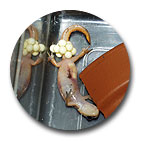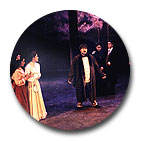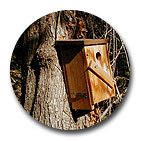Curriculum
Faculty and the Canyon
Some ways the Reed faculty use the canyon for teaching and research

Robert Kaplan (Biology)
"I teach introductory biology, population biology, field biology and conservation biology. Many of these classes make regular use of the Canyon, especially in the quest of the Oregon salamander, Ensatina eschscholtzii oregonensis. Students have also studied stickleback fishes, lampreys, birds and a variety of invertebrates. Many independent projects and senior theses have been developed from work in the Canyon."
 Jay Mellies (Biology)
Jay Mellies (Biology)
"For Introductory Biology we are testing for the presence of coliform bacteria in the Reed Canyon surface water; coliforms, in particular E. coli, are indicators of sewage contamination. This will be an ongoing study, performed by students, to help monitor the health of the canyon ecosystem. For my Microbiology course, BIO 358, we are growing communities of microbes from the Canyon in Winogradsky columns. These columns are self-contained systems driven only by energy from sunlight, and I will use them in my course to talk about microbial diversity, metabolic diversity, and the cycling of nutrients."
 Kathleen Worley (Theatre)
Kathleen Worley (Theatre)
"I have regularly used the canyon for 'blind trust walks' in acting class. Students walk through the canyon in pairs, one 'blind' (with eyes closed) and one sighted to act as guide to protect and direct exploration with senses other than sight. When the class has an odd number of students, I sometimes guide; and I love seeing the sense of astonishment on people's faces as their fingers encounter the feathery flower remnants of invasive clematis or the chill water of the canyon stream."
"Years ago when I directed Chekhov's 'The Cherry Orchard' using acting techniques drawn from Stanislavski's work, I took the actors playing the family on an improvisatory picnic in the canyon. They remained in character the entire time, responding to the place as if it were part of the beloved estate which they now may lose. Several of the actors told me it was one of the most useful parts of the rehearsal process."
 Stephen Yezerinac (Biology)
Stephen Yezerinac (Biology)
"From my perspective, the most noteworthy aspect of the Reed Canyon is that it provides easily accessible populations of insects, fish, birds and mammals for use in teaching and research. For example, class labs and independent student research projects in Bio 342, Animal Behavior & Behavioral Ecology, have focused on waterstriders, sculpins, waterfowl and squirrels. Thesis research (Bio 481) has included work on web building behavior of spiders and song and plumage of jays. Finally, bird nest boxes are placed throughout the Canyon to encourage nesting of swallows. These urban swallows allow comparison with swallows on Mount Hood that are part of my research on reproductive behavior of birds."
"Whether it's a rainy winter day recording bird song, or a sunny afternoon watching waterstriders, the Reed Canyon is a true ecological field site and not merely a pleasant park in the city."